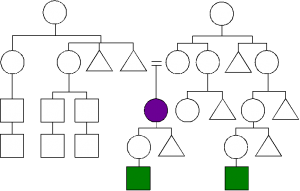![]()
![]()
![]()
![]()
![]()
![]()
ēnnaral
ēnnaral is derived from āral and is the word for 30 base 8, or 24 base 10. The more prosaic way to say 30 is wījtōr. Both terms are in common usage.
![]()
![]()
![]()
![]()
![]()
![]()
ēnnaral
ēnnaral is derived from āral and is the word for 30 base 8, or 24 base 10. The more prosaic way to say 30 is wījtōr. Both terms are in common usage.
![]()
![]()
![]()
ēnne
We’re still on this sentence in the 17th Conlang Relay Text:
il ñamma jacēha ja ñi sāen rā jakērþe ōl nō ā macūma il ñi jakērþe jasērre tō jōrwe ēnne;
When the man attempted to get on to the horse,
then ñi horse jasērre tō jōrwe ēnne.
We know ansērre, here modifying “horse” means “standing upright”. tō here acts as an instrumentative marker, so jōrwe ēnne is the means by which the horse stands upright. jōrwe looks very much like sōrwe which means “one’s legs”. The s– prefix is only used for animates, however, and the horse is not high enough on the personhood scale to qualify. So, an inanimate form is used instead. Then comes ēnne, which is the word for the number 2, telling us that the horse stood upright on two legs as opposed to one or three or some other number.
When the man attempted to get on to the horse, then the horse stood upright on two legs.
![]()
![]()
![]()
![]()
![]()
![]()
anēspe
The sixth sentence of the 2nd Inverse Relay text:
il ñi liēþ rā anmāxxānwi nīkan jarēlān jēspe il ñi anālhāri ansēlni;
jēspe is the inanimate singular form of anēspe which means “continuing in the same state or place, waiting”, so jarēlān jēspe is a continuing light wind, making ñi liēþ rā anmāxxānwi nīkan jarēlān jēspe “We go to a (wide) plain with a continuing light wind.”
![]()
![]()
![]()
![]()
![]()
![]()
anēlki
ice, an expanse of ice. A small piece of ice would be called jēlke.
![]()
![]()
![]()
![]()
![]()
jēwār
a lake. So, completely inland, not part of the sea, forming at the bottom of a basin of some sort, and generally large enough to float a boat or otherwise be a significant feature in the landscape.
sū jēwāri āñ la jamāonre;
Among the lakes was a city.
![]()
![]()
ē … ē
This is another coordinating conjunction and means simply ‘and’. This also allows us to complete the second clause of the Kēlen rephrasal of the 1st article of the Universal Declaration of Human Rights.
Wait, you say, what about lenārre and lewēren. Those are simply the first person possessed forms of senārre and sewēren, which I already discussed when covering body parts.
The second clause:
| tō | pa | ñēim | tēna | ē | lenārre | ē | lewēren |
| because | PA | we | each | and | soul | and | identity |
| Because we each of us have soul and identity… | |||||||
Our progress:
tō la mēli manaren tēna ñe anhēnārīki anīλi jañāona jañēie
‘Because each person is an equal thread in the cloth of society…’
tō pa ñēim tēna ē lenārre ē lewēren
‘Because we each of us have soul and identity…’
tō jāo hēja senneñ anēla anciēri ke mān mo mīþa
ien sexe mo maþūskīri mo sāim maþūskīriēma cī;
![]()
![]()
![]()
![]()
![]()
![]()
mēlīña
grandchild, one’s daughter’s child, any small child of any gender in one’s clan. The green squares in the diagram are the purple circle’s mēlīñi.

![]()
![]()
![]()
ēmma
The modifier ēmma refers to the outside of something. So, rū NP ēmma is from the outside of NP or out of NP. The expected expression rā NP ēmma is not used. The word ēmma is related to yesterday’s word mē.
![]()
![]()
![]()
![]()
![]()
![]()
rūjēmma
Likewise rūjēmma is rū NP ēmma without a specified location, and so means ‘out’. The expected expression rājēmma is not used.
![]()
![]()
![]()
![]()
mēla
a person.
If we’re going to discuss body parts, here is the word for the complete package. A person is made up of four parts: sanārme, sārena, senārre, and sewēren. These will be discussed over the next four days.